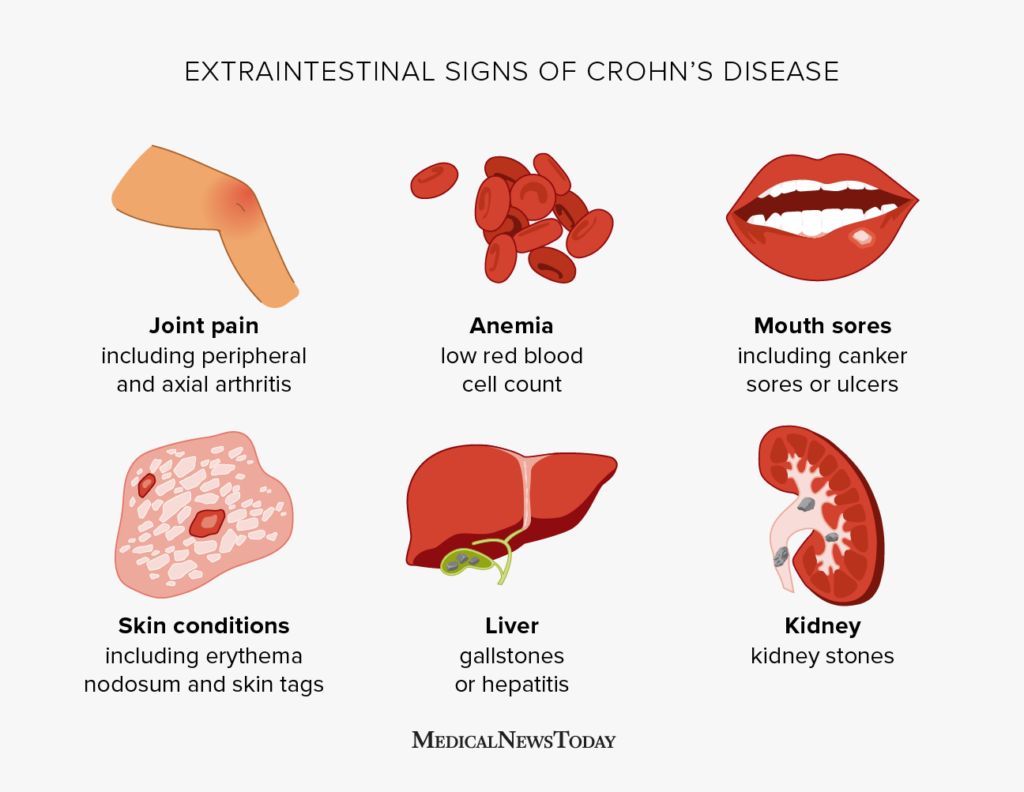Mouth ulcers, peripheral arthritis, and eye inflammation are all possible extraintestinal symptoms of Crohn’s disease — disease-related effects occurring outside the gastrointestinal (GI) system.
Crohn’s disease is one type of inflammatory bowel disease (IBD). It is a lifelong condition that causes inflammation in the GI system that can be progressive, affecting any part of the GI tract from the mouth to the anus.
As a GI condition, Crohn’s disease classically presents with a variety of gastrointestinal symptoms, such as diarrhea, rectal bleeding, and bowel urgency.
However, many people living with IBD also experience symptoms outside of the GI tract. These extraintestinal symptoms, known formally as extraintestinal manifestations (EIMs), affect tissues throughout the body.
This article lists potential extraintestinal symptoms of Crohn’s disease and ways to manage them.

According to a 2021 research review, musculoskeletal EIMs, including joint pain and inflammation, affect around 46% of people living with IBD but appear to decrease with age.
Potential types of arthritis and joint pain that can occur in Crohn’s disease include:
- Peripheral arthritis: Joint inflammation in the larger joints of the body.
- Ankylosing spondylitis or sacroiliitis: Inflammation in the joints and ligaments of the spine.
- Enthesitis and dactylitis: Inflammation of the junction where connective tissue inserts into the bone.
Healthcare professionals may prescribe nonsteroidal anti-inflammatory drugs (NSAIDs) to treat these EIMs. They may escalate this to sulfasalazine (Azulfidine) or biologics for some people.
However, some medications may irritate the GI tract and worsen symptoms of Crohn’s disease.
Home care may include rest, application of moist heat to the joint, and range of motion exercises under the guidance of a rehabilitation specialist.
Anemia affects approximately 1 in 3 people with IBD. Anemia occurs when the red blood cell count in the body drops below baseline levels.
In Crohn’s disease, anemia is an EIM directly related to the GI tract’s diminished ability to absorb vital nutrients such as iron, folic acid, and vitamin B12, intestinal bleeding, and being in a chronic inflammatory state.
Anemia
- skin that looks paler than usual
- chills
- fatigue
- headaches
- shortness of breath
- irregular bleeding
- dizziness, lightheadedness, and fainting
The most important anemia treatment for someone with IBD involves treating the underlying IBD. People may recover from anemia if they properly manage the disease.
Doctors may suggest nutritional supplements to treat anemia. Blood transfusions and intravenous iron may be necessary in severe cases or when a person does not tolerate oral iron supplements.
Eating iron-rich foods and those that contain B12 may also
Oral aphthous ulcers are mouth sores that people
According to a
Canker sores may appear
- small, round ulcers on the tongue, lips, or cheeks
- ulcers that are gray, white, or yellowish
- burning or tingling sensation in the mouth
Canker sores are not transmissible. They may be related to poor vitamin absorption due to GI inflammation.
Over-the-counter (OTC) medications can help numb the pain of mouth sores. Mouth rinses and other OTC antiseptics can also help improve healing and prevent the spread of infection.
Eating spicy or abrasive foods may aggravate EIM mouth sores.
Skin EIMs affect an estimated
Examples of
- Erythema nodosum: Sensitive red bumps on the extremities.
- Pyoderma gangrenosum: Blisters that progress to ulcers on the arms and legs.
- Sweet syndrome: Tender skin lesions primarily on the upper body accompanied by fever.
- Hidradenitis suppurativa: A condition that can cause small, painful lumps and abscesses under the skin.
In most extraintestinal skin symptoms, treating IBD is the treatment for the EIM.
Some conditions, such as acrodermatitis enteropathica, can improve with proper nutrition, which decreases the risk of nutrient deficiencies.
EIMs can also affect the internal organ function of the liver and kidneys. Serious liver disease is an EIM affecting an estimated 5% of people living with IBD.
Liver complications can include:
- Hepatitis: Liver inflammation.
- Gallstones: Pebble-like buildup in the gallbladder.
- Fatty liver disease: Buildup of fat deposits that lead to scarring.
- Primary sclerosing cholangitis (PSC): Bile duct inflammation.
Of these, a
Kidney EIMs are rare but
- Kidney stones: Accumulations of crystals in the kidney.
- Fistulas: Abnormal tracts between the intestines and other organs.
- Amyloidosis: Abnormal protein deposits in organ tissue.
- Glomerulonephritis: Kidney lesions that affect filtration.
- Tubulointerstitial nephritis: Inflammation affecting the kidney’s tubules.
Medications to treat IBD can cause kidney dysfunction in a very small percentage of people.
Crohn’s disease can affect more than just the areas mentioned above. It can also cause EIMs that affect the following:
- eyes
- vascular system
- lungs
Crohn’s disease can also affect a person’s mental health. For example, a
Extraintestinal symptoms of Crohn’s disease can affect multiple organ systems beyond the GI tract.
They are common in the skin, joints, and mouth. Extraintestinal symptoms of Crohn’s disease are associated with greater morbidity and lower quality of life in IBD.
While medications, exercises, diet changes, and supplements may all help improve EIMs, long-term relief comes through the management of Crohn’s disease itself.
